If you’re new to the sewing world, the sheer volume of sewing machines on the market may seem overwhelming. Even experienced sewers often hesitate to try out specialized machines because they find the wide range of models confusing. For example, if you’re considering purchasing a serger vs a sewing machine, you probably want to know what the difference is between these machines.
A serger is a specialized kind of sewing machine with unique capabilities. The main difference between a serger and a sewing machine is that a serger specializes in simultaneously sewing a seam, cutting off the seam allowance, and enclosing the raw edge all at the same time.
In this article, you’ll learn how a serger works and how it is different from a regular sewing machine. You’ll also find some key questions to consider as you decide whether or not you need one.
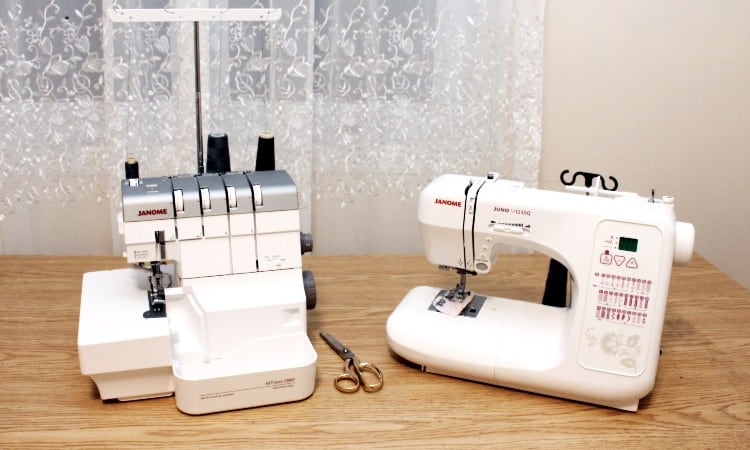
What is a Serger/Overlock Machine?
A serger sews a seam closed and simultaneously stitches over the edge of the seam allowance, entirely encasing the seam. Most sergers also trim the extra seam allowance as they sew. These machines create neat, perfectly finished seams with factory-like precision.
You may also see sergers referred to as overlock machines. The over-the-edge stitch these machines use is called an overlock stitch. American companies usually call these machines sergers. European companies call them overlockers or overlock machines.
The most obvious characteristic of sergers is that they use several spools of thread at once. Depending on the model, your machine may use anywhere from two to five cones of thread as it sews.
Sergers usually use the really large, triangular-shaped cones of thread you may have noticed in most sewing stores. They need a lot of thread to create overlock stitching.
Most sergers use polyester thread. This thread has a bit of stretch to it and is strong enough to hold up to the fast, precise sewing required in these machines.
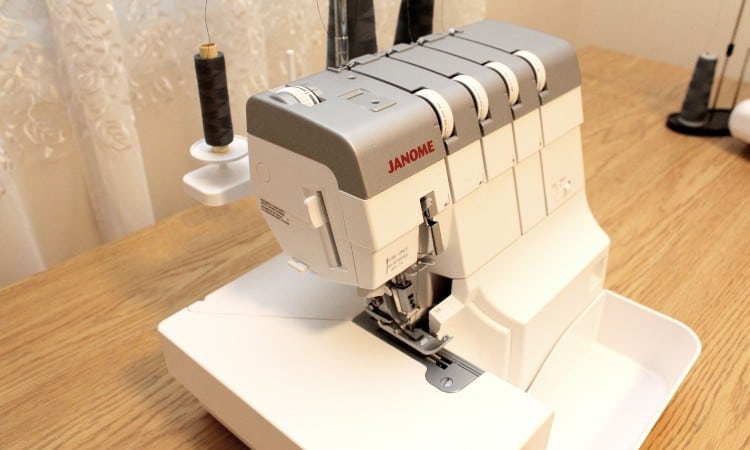
You probably enjoy matching just the right shade of thread to your material for many sewing projects. You may have to break this habit! Many sewers don’t try to match serger thread to the color of their fabric because the big cones of thread cost too much.
It also takes a bit of work to rethread these machines. You don’t want to be swapping out spools every other project!
The multiple sources of thread create a variety of overlock stitches. A normal sewing machine creates one row of straight stitches as it sews a seam. A serger creates those straight stitches, but it also sews a pattern of stitches over the raw edge of the seam allowance.
Another special characteristic of many sergers is something called a differential feed. Differential feed moves the feed dogs in the machine at differing speeds at the same time. This can create pretty ruffles and help slide knit fabric through without stretching.
So, how does a serger work? Unlike most sewing machines, sergers do not use bobbins. Instead, they create thread loops and use stitch fingers to lock threads over the edge of the fabric as they sew. Stitch fingers are small metal prongs to the side of the needle plate.
Not all sergers are created equal, but they can all make an overcast/overlock seam. You may find these machines ideal for creating a tiny hem using this stitch as well. Most models can also create flatlock seams and a perfect cover stitch.
What Does a Sewing Machine Do?
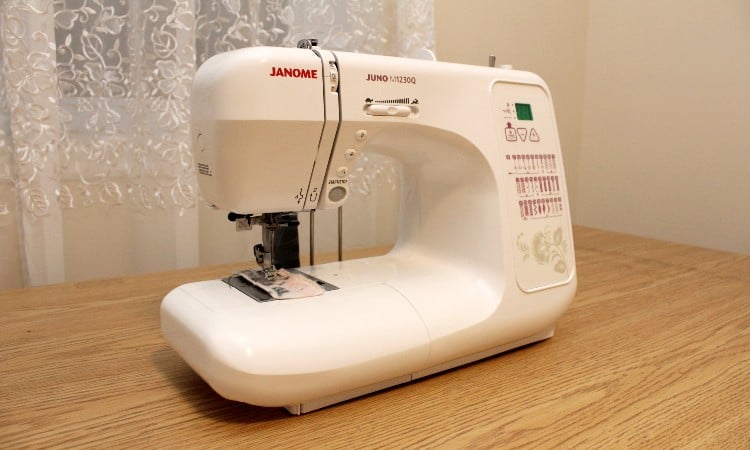
In the simplest possible terms, a sewing machine uses thread to stitch together several layers of fabric. Most domestic machines can sew a straight stitch, a zigzag stitch, and some more complex stitches such as buttonholes or even pretty flowers.
You can use the average domestic machine to sew seams in many ways, hem fabric, set a zipper, sew facings, create a buttonhole, and often stitch some embroidery designs as well.
Modern sewing machines are usually computerized and come with a wide array of stitching patterns programmed into them. The basic mechanics of how the machines work has not changed a lot since the first sewing machines were invented during the industrial revolution, though!
So, how does a sewing machine work? The needle pulls a thread from the spool and pushes it in and out of the fabric as the machine runs. Each time the needle pushes through, the bobbin (basically a tiny spool of thread beneath the needle) uses a special hook to catch this thread and slide the bobbin thread through it. This holds the thread on both sides of the fabric, creating stitches!
Things get a little more complicated when you set your machine to fancier stitches. Some domestic machines also have a double-needle setting. The basic concept of how the needle and bobbin work together remains essentially the same even for complex machines, though!
Serger vs Sewing Machine: What’s the Difference?
The main difference between a sewing machine and a serger is that sergers use an overlock stitch to encase a seam completely as they sew. In one sense, sergers have more specialized and limited capabilities than most sewing machines. On the other hand, sergers accomplish multiple tasks at once that you would have to complete one at a time while using a regular machine.
Design
One key difference in the design of these machines is that sergers usually have a rack of tall thread cones on top. Most sewing machines function using one spool of thread and one bobbin. Sergers draw from three to five cones of threads and use looper threads instead of a bobbin.
Usually, sergers also have a squatter, more squared design than sewing machines. Most sewing machines feature a longer neck. This is because these machines require more wiggle room for tasks like sewing in zippers, while sergers are designed to sew seams.
Construction
Most prominent sewing machine brands also manufacture and sell sergers. You can find Brother, Janome, and Singer models at any sewing store, the manufacturer’s website, or on Amazon.
Of course, just like sewing machines, some sergers come with more bells and whistles than others.
Number of Threads
 You already know this by now, but a key difference between these machines is the number of threads they use.
You already know this by now, but a key difference between these machines is the number of threads they use.
Sewing machines use one spool of thread and one bobbin to create stitches (unless you are using a double-needle, but even that only uses two spools of thread).
Sergers draw from two to five cones of thread at once to create finished seams that will not fray easily.
Cutting Knife
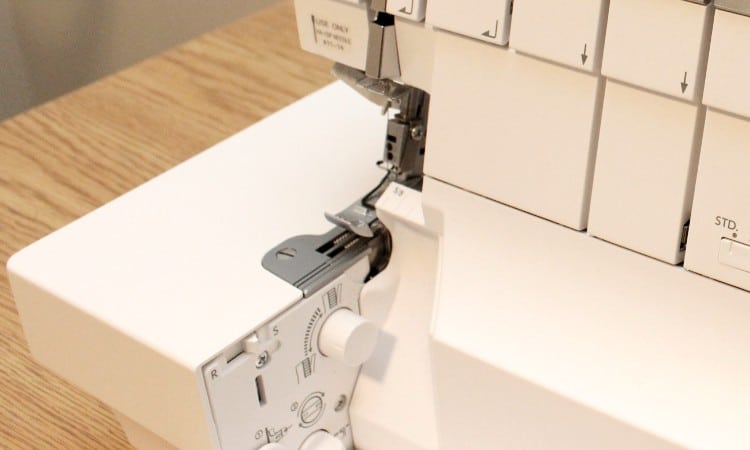
Sergers have some features that average sewing machines lack, such as a cutting tool to trim the seam allowance. This creates a perfect finish while also sewing the seam.
You can use a zigzag stitch to finish a seam on a regular machine, of course, but you have to complete this process in stages: first, sew the seam. Second, remove the fabric from the machine and trim the seam allowance. Finally, set your machine to a zigzag stitch to finish the seam.
Because sergers have a cutting tool, they can do all of this at one go!
Number of Stitches
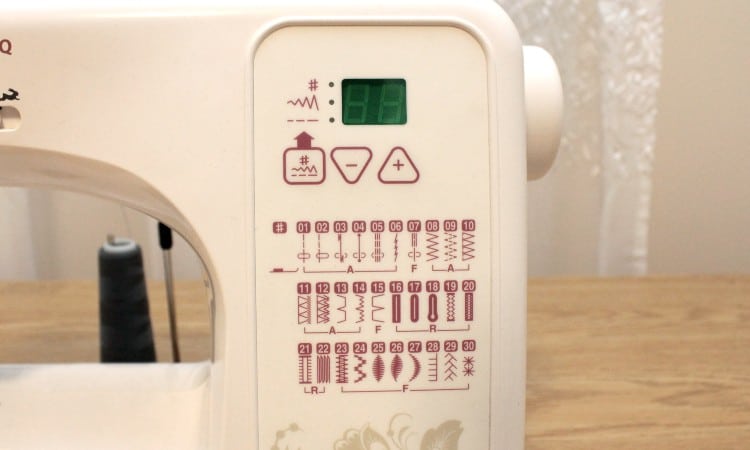
Most sewing machines today come programmed with dozens of possible stitches. Sergers usually do not. They provide limited types of stitches, but these can be used for many, many different tasks.
That said, a basic sewing machine can also perform many unique tasks that overlocking machines cannot.
Easy to Thread
 With a little practice, you can easily learn how to thread a normal sewing machine. You might find sergers more difficult to thread.
With a little practice, you can easily learn how to thread a normal sewing machine. You might find sergers more difficult to thread.
This is because you have to learn the thread path for three to five different threads instead of just one!
It’s a good idea to refer to the owner’s manual and possibly watch some youtube clips if you are new to this.
Once you get the hang of it, though, setting up your serger will be a breeze.
Performance: Stitches per Minute
Every sewing machine and serger has slightly different stitching speeds, but sergers usually whip out far more stitches per minute than the average sewing machine. Most sewing machines sitch between 1000 and 1500 stitches per minute. Sergers average anywhere from 1300-2200 per minute!
Learning Curve
You may find sergers more difficult to understand than your normal sewing machine.
If you follow the same path as many home sewers, you probably started with a regular domestic machine and learned basic skills like sewing a straight seam, hemming a garment, and adding zippers. Eventually, you decide you want to up your game and create professional-looking finished seams, so you purchase a serger.
Are sergers harder to use than sewing machines? Not necessarily, but most sewers come to them after learning how to use a regular machine. Sergers work differently, which can be confusing to someone used to working on a sewing machine.
The good news is that sergers do fewer things than most sewing machines. Once you master those few skills, you’re all set!
Price
Sergers and sewing machines have pretty similar price ranges. You can purchase a new, basic serger for about $300, but you can also buy super-advanced models for as much as $2,000!
Likewise, decent domestic machines usually sell at around $200-$300. You can also find expensive sewing machines programmed with a thousand different stitches, and these can cost as much as a couple of thousand dollars. Most really, expensive sewing machines are computerized embroidery machines, but that is a whole other story!
Pros and Cons of Sewing Machine
 Here’s a quick recap for you, highlighting the pros and cons of the average sewing machine.
Here’s a quick recap for you, highlighting the pros and cons of the average sewing machine.
Sewing machines:
- Generally, use one spool of thread and one bobbin
- Feature a long-necked design to allow space for manipulating fabric for complex tasks like setting sleeves
- Can perform a wide range of sewing tasks, including sewing facings, hems, zippers, buttonholes, ruffles, and seams
- Often come programmed with dozens of stitches
- Can finish seams with the additional step of sewing a zigzag stitch to enclose the raw edge of the fabric
- Cannot simultaneously sew a seam and encase the edge of the seam allowance
- Cannot sew a stretchy overlock stitch
Pros and Cons of Serger
 And here’s another quick summary, highlighting the pros and cons of the average serger.
And here’s another quick summary, highlighting the pros and cons of the average serger.
Sergers:
- Use three to five cones of thread at once
- Usually have a smaller shape and a shorter neck
- Can perform a select range of specialized sewing tasks that involve seams with encased edges
- Can sew very quickly, averaging 1000-2000 stitches per minute
- Can simultaneously sew a seam, cut off the extra fabric, and encase the edge of the seam allowance
- Create very strong and secure seams perfect for children’s clothes or anything that needs to hold up under rough handling
- Cannot perform sewing tasks like setting a sleeve, sewing a facing, inserting a zipper, or sewing a buttonhole
Can You Use a Serger for Regular Sewing?
You can complete some sewing tasks just using a serger, but other tasks require features that overlocking machines can’t provide. Ultimately, this depends on the kind of sewing you want to do.
If your sewing project involves lots of straight seams and maybe some hemming, you can probably get away with using only a serger. This will even save you time! A serger can’t replace all the common functions of a sewing machine, but it can prove a more efficient alternative for many projects because it accomplishes several tasks simultaneously, unlike a sewing machine.
The nature of overlock stitches also makes sergers excellent for sewing on knit fabric. These stitches have a bit of stretch to them. Regular sewing machine stitches do not stretch, though you can use a zig-zag stitch on knits in a pinch.
On the other hand, if you plan to sew a wedding dress, you will need to topstitch, sew in facings, set sleeves, add a zipper, probably sew on lots of tiny buttonholes or button loops, and generally do a great deal of fiddly, complicated sewing tasks that are best suited to a regular sewing machine.
Do I Need a Serger?
Whether or not you need a serger depends on the kind of sewing you like to do. Many simple sewing tasks become easier and more efficient when you use a serger.
Also, if you sew professionally, you probably want your finished products to have overlocked seams. This looks much more professional.
If you’re wondering if it is worth it to buy a serger, here’s your answer: if you sew regularly or plan to start a home-based Etsy shop, you will benefit from using an overlocking machine. If you sew items that need to hold up under tough wear and tear, such as sports jerseys or children’s clothes, you might want a serger because overlocked seams last longer.
If you sew once in a while, mainly for yourself or your family, your serger might become a very expensive decoration in your craft room.
That said, a serger probably can’t replace your sewing machine. It lacks capabilities that you may need for everyday sewing. In fact, if you only have space or money for one machine, you’re probably better off purchasing a sewing machine.
Of course, in the best of both worlds, you can buy one of each! Or, if you want to get fancy, you can look into combo machines.
Sewing Machine with Serger Function
Some regular sewing machines do feature the ability to sew an overlocking stitch with a tool called an overcast foot. The great benefit of this is that you may save money by buying just one machine, and you will save storage space if you only have to store one machine!
While you may legitimately think that a sewing machine with an overlock stitch will solve all your problems, you should consider a couple of potential issues first. Since these machines with overlock capabilities still only have one or two thread sources, they will never create a stitch as strong and stretchy as a real overlocker. Plus, even with the overcast foot, your regular sewing machines will not have the trimming tool that cuts away seam allowance while sewing.
Is it worth trying an overcast foot? These little gizmos can help you sew nice finished seams and create lovely rolled hems. If you want perfect encased seams, though, you’re eventually going to want a real serger.
Sewing Machine Serger Combo
Unfortunately, none of the major companies currently offer a true serger/sewing machine combo. For a hot second, Singer sold a very fancy combo machine that incorporated lots of sewing machine stitches, computerized embroidery machine options, and serging abilities, but it has been discontinued.
You might think that this is all a marketing ploy because the big companies want you to buy two separate machines from them and spend more money. You’re probably at least partly correct! It’s also true, though, that sergers and sewing machines run very different processes, and combining those operating methods doesn’t work well.
Think about the complex looping of threads sergers use to make an overlocked seam, compared to the simple needle-and-bobbin of the average sewing machine. Each of these machines performs its own kind of task using completely different processes.
Best Serger Sewing Machine
The best serger for you is one that fulfills your particular sewing needs. If you’re just starting, you probably want a three-to-four thread model that comes with color-coded threading instructions. If you’re a sewing pro, you know that stitches per minute can make a big difference, and you’re also looking for a four-to-five spool machine with more stitch options.
Either way, you can find sergers for sale through many venues. If you want a new machine with a warranty, consider buying directly from the manufacturer, searching Amazon, or visiting a sewing store like Joann Fabric. If you want something cheaper but less guaranteed, you can always find various sewing machines for sale on eBay and Craigslist.
It’s a good idea to research a good bit to determine what capabilities each model has before committing yourself. Even if you want to buy a serger at your local thrift store, you can look up the model on Amazon to find out exactly what functions that model has, what limitations it has, and how easy it is to use!
What is the Best Serger for Beginners?
If you’re new to sergers, you probably want to start with a model that doesn’t cost too much. You should also look for a model that uses fewer threads and comes with clear and color-coded instructions.
You might also prefer to stick to well-known brands such as Brother and Singer. Both companies offer excellent machines for beginners.
Here are a couple of models designed for beginners to give you an idea of what is out there.
Singer Finishing Touch 14SH654 Serger
 The Singer brand often means reliability and quality in the sewing community, and this nicely designed model continues that tradition. This sturdy machine offers both three or four thread stitch options and six different stitches. It has a color-coded threading system and differential feed that will allow you to create ruffles and work easily with knit fabric.
The Singer brand often means reliability and quality in the sewing community, and this nicely designed model continues that tradition. This sturdy machine offers both three or four thread stitch options and six different stitches. It has a color-coded threading system and differential feed that will allow you to create ruffles and work easily with knit fabric.
The machine also features a free arm and an extra-high presser foot for working with thick or bulky materials. In terms of pricing and capability, this model would make an excellent first serger for any home sewer.
Brother Serger, 1034DX, Durable Metal frame Overlock Machine
 Another brand that stands out for beginners and pros is Brother. Brother Serger 1034DX offers a speed of 1,300 stitches per minute, both three and four-thread stitches, and three accessory feet. One thing that makes this model unique is its durable metal frame. It might feel heavier, but it will last a long time!
Another brand that stands out for beginners and pros is Brother. Brother Serger 1034DX offers a speed of 1,300 stitches per minute, both three and four-thread stitches, and three accessory feet. One thing that makes this model unique is its durable metal frame. It might feel heavier, but it will last a long time!
This machine also comes with tools to make the learning process easier for beginners. These include instructional videos and color-coded thread paths. Finally, this machine has a cool “trim trap” that catches all the cut-away seam allowance as you sew!
What is the Best Serger for Professionals?
Professionals look for speed and functionality in a serger. Singer, Brother, Janome, and Juki all sell excellent professional-grade machines.
These reviews will give you a bit of insight into professional sergers.
SINGER Professional 14T968DC Serger Overlock with 2-3-4-5 Stitch Capability
 Despite its moderate price range, this Singer model 14T968DC comes with professional features like three, four, or five thread stitches.
Despite its moderate price range, this Singer model 14T968DC comes with professional features like three, four, or five thread stitches.
It offers several cover-stitch options and features not one but four different rolled hem styles.
This model is known for its quiet operation, a rarity in sergers! The five-spool threading process might prove challenging.
On the other hand, this model does offer a wide range of stitches that professionals may need.
Janome MyLock 634D Overlock Serger, with Self Threading Lower Looper
 If you’ve been around the sewing block a few times, you probably recognize the Janome brand. This company builds high-quality, professional-grade machines. Janome MyLock 634D offers self-threading lower loops to save you lots of set-up time.
If you’ve been around the sewing block a few times, you probably recognize the Janome brand. This company builds high-quality, professional-grade machines. Janome MyLock 634D offers self-threading lower loops to save you lots of set-up time.
The machine also features a retractable knife that allows you to sew with or without trimming the seam allowance. It also includes differential feed and adjustable cutting widths. Its stitch options include a variety of rolled hems.
The only downside to this pricey and professional model is that it only provides two, three, or four thread stitches. To make up for that, it comes with cool attachments like a beading tool and a piping foot!
Conclusion
Sergers and sewing machines do not do the same things. They can perform some of the same tasks, but each machine has a unique design and operating method. Sergers primarily create beautiful overlocked seams. Sewing machines offer a broader range of abilities but do not create overlocked seams.
Do you have a favorite model of sewing machine or serger? Have you tried both types of machines? Leave a comment below to let us know what kind of sewing works best on a serger or a sewing machine!